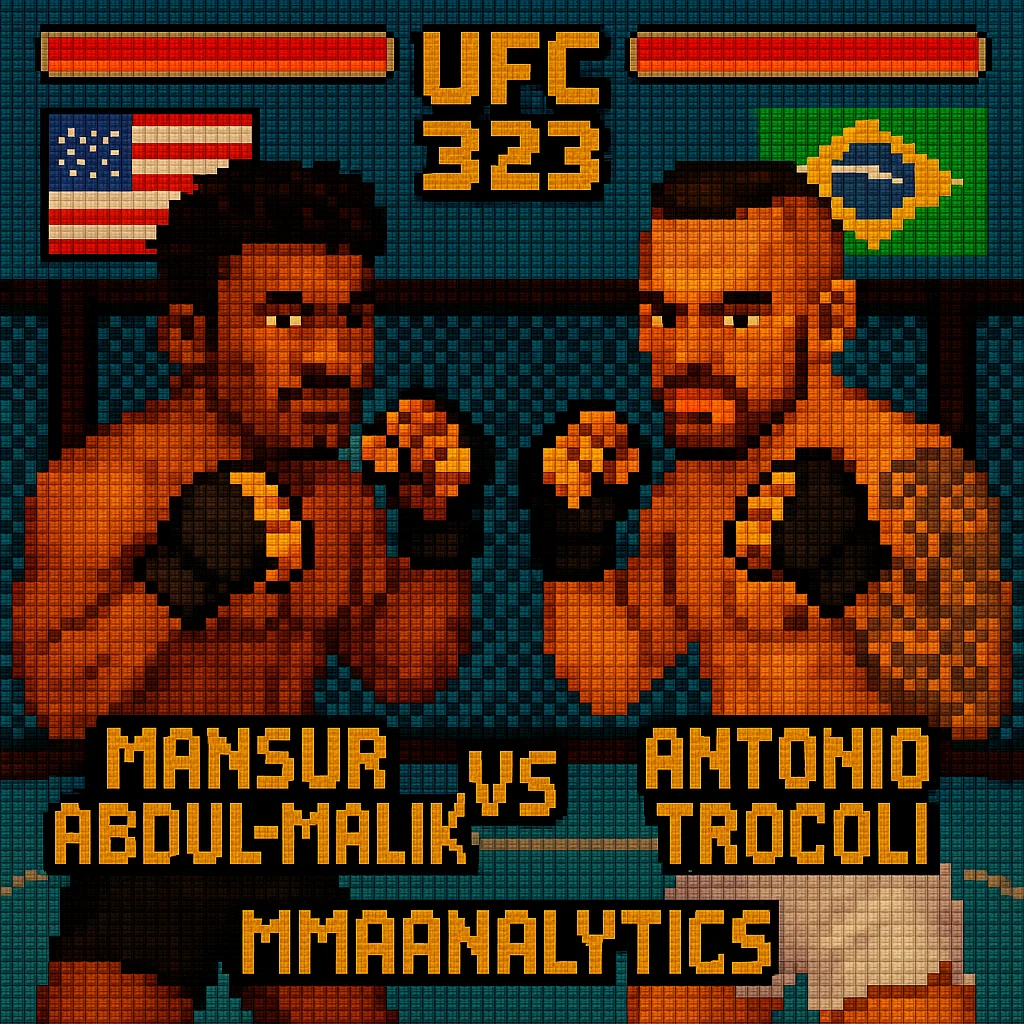Mansur Abdul-Malik vs Antonio Trocoli
Men's Middleweight Bout • UFC 323
Saturday, December 6, 2025

Explore Detailed Fighter Profiles
Click on either the fighter's name or profile image for each fighter to access comprehensive UFC statistics including striking metrics, grappling data, clinch performance, complete fight history, offensive & defensive analytics, and round-by-round breakdowns.
Mansur Abdul-Malik
Fighter Metrics
Victory Methods
Win Round Distribution
Last 5 Fights
| Date | Opponent | Result | Method |
|---|---|---|---|
| 2025-06-14 | Cody Brundage | D | Draw (Overturned) (R3, 0:36) |
| 2025-02-22 | Nick Klein | W | TKO - Knee and Punches (R2, 3:24) |
| 2024-11-09 | Dusko Todorovic | W | TKO - Ground Punches (R1, 2:44) |
| 2024-08-13 | Wesley Schultz | W | TKO - Elbows and Punches (R2, 3:55) |
| 2024-02-09 | Allan St-Gelais | W | KO - Punches (R1, 1:40) |
Antonio Trocoli
Fighter Metrics
Victory Methods
Win Round Distribution
Last 5 Fights
| Date | Opponent | Result | Method |
|---|---|---|---|
| 2024-11-09 | Tresean Gore | L | Submission - Guillotine Choke (R1, 1:23) |
| 2024-06-22 | Sharabutdin Magomedov | L | TKO - Knee and Punches (R3, 2:27) |
| 2021-11-21 | Reslley Menezes | W | Technical Submission - Rear Naked Choke (R1, 2:10) |
| 2019-07-09 | Kenneth Bergh | NC | Overturned by NSAC (R1, 3:57) |
| 2018-11-10 | Fabio Moreira | W | Decision - Unanimous (R5, 5:00) |
📊 Technical Radar Comparison
Legend & Notes
- • SLpM, TD15, Sub/15 are normalized to 0–100 for plotting.
- • Percent metrics (StrAcc, StrDef, TDAcc, TDDef) are raw %.
- • Tooltip shows true raw values with units.
- • Colors: Blue = Mansur Abdul-Malik, Red = Antonio Trocoli.
📊 Detailed Statistical Comparison
Technical Score
Cardio Score
Overall Rating
🥊 Fight Analysis Breakdown
🏆 Mansur Abdul-Malik Key Advantages
Elite 82% takedown defense creates a fortress that keeps the fight standing where his volume and defense advantages dominate. Trocoli's weak 11% TD accuracy—landing zero of nine career UFC attempts—signals he cannot force the wrestling exchanges needed to slow Abdul-Malik's pace. This defensive wrestling superiority is compounded by the large 30-foot cage geometry, which provides ample space for lateral movement and sprawl recoveries.
Massive output advantage (4.27 vs 1.29 strikes per minute) combined with a 28-point defensive edge (51% vs 23% striking defense) creates consistent round-winning differentials. Abdul-Malik's ability to land over three times the volume while absorbing significantly less damage means he controls the scoring narrative throughout each round.
Perfect 100% finish rate across eight career victories with heavy early-round clustering showcases immediate finishing instinct. His finishing power translates across multiple contexts: ground-and-pound swarms, clinch breaks with elbows and knees, and standing combinations.
⚠️ Unfavorable Scenarios
📋 Likely Gameplan
🚀 Antonio Trocoli Key Advantages
Most credible upset path lies in opportunistic guillotine opportunities during scrambles. Trocoli's front-headlock specialization creates legitimate danger if Abdul-Malik over-commits or gets caught in chaotic exchanges.
Massive 6'6" frame provides natural leverage advantages in clinch positions, supporting powerful collar ties and knees. If he can force fence battles, his height becomes a significant asset.
Recent 83-second finish demonstrates ability to end fights quickly when positions are secured. Chaos is his ally.
⚠️ Unfavorable Scenarios
📋 Likely Gameplan
🎯 Fight Prediction Analysis
Data-driven prediction model based on statistical analysis
📊Detailed Analysis Summary
🏟️Cage Dynamics (30ft – Large Cage)
The large 30-foot cage fundamentally reshapes this matchup in Abdul-Malik's favor. It amplifies the value of footwork and distance management, allowing him to leverage his superior output and TDD to control ranges. It reduces Trocoli's ability to trap him against the fence, correlating directly with Abdul-Malik's minute-winning profile.
🎯Technical Breakdown
Abdul-Malik's 231% striking output advantage (4.27 vs 1.29 SLpM) and 28-point defense gap (51% vs 23%) mean Trocoli gets hit clean on nearly 80% of strikes thrown at him. Trocoli's path—front-headlock submissions—requires entries his 11% TD accuracy suggests won't materialize against Abdul-Malik's 82% TDD and patient approach.
⚡Key Battle Areas
1) Initial striking exchanges where Abdul-Malik's volume meets Trocoli's porous defense. 2) Defensive wrestling moments when Trocoli attempts desperation takedowns; history favors stuffs. 3) Accumulation phase in R2-R3 where Abdul-Malik's cardio edge (82 vs 58) takes over against a fading Trocoli.
🏁Final Prediction
Most likely outcome: Abdul-Malik by KO/TKO in rounds 1-2 (56% probability) or unanimous decision (22%). Trocoli's 21% win probability is almost entirely submission-based (12%), but the large cage makes that path significantly harder.
Overall lean: Mansur Abdul-Malik 79% vs Antonio Trocoli 21%.
💰 Betting Analysis: Model vs Market
Detailed value assessment in the betting market
📊Market Odds
🤖Analytical Model
Model Props (Fair Odds)
💎Value Opportunities
MAXIMUM VALUE
Model: 56% | Strong Edge
GOOD VALUE
Model: 72% | Target -200 to -260
SLIGHT VALUE
Model: 22% | +300 or better
🎯 Comprehensive Probabilistic Analysis
100 hypothetical fight simulation based on statistical data
🏆Outcome Distribution - Mansur Abdul-Malik
💥Outcome Distribution - Antonio Trocoli
🎯 Final Confidence Assessment
Confidence level and risk considerations
Confidence Level
Strong confidence given multiple aligned edges and favorable cage dynamics.
✅Supporting Factors
- • Minute-winning striking differential
- • 82% TDD vs 11% TD accuracy
- • Large 30ft cage favors range control
- • 100% finish rate with early clustering
⚠️Risk Factors
- • Front-headlock submissions in scrambles
- • Over-commitment on entries
- • Power knees in clinch from taller frame
- • Variance in 3-round pacing
